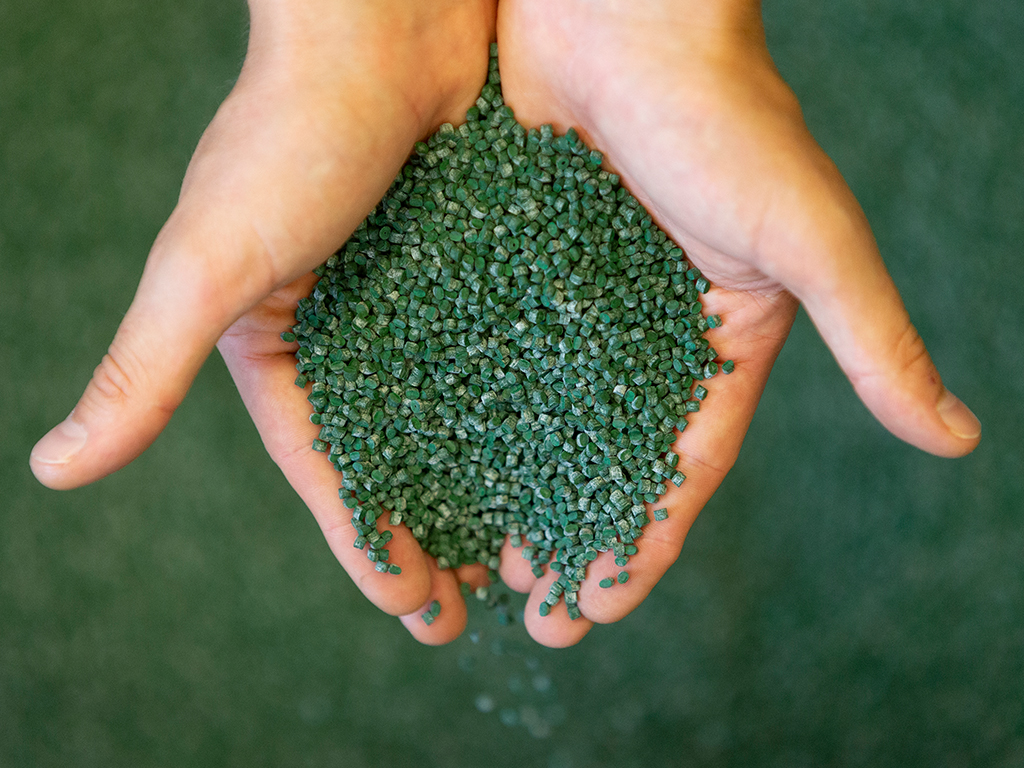Hollarts and sustainability
Plastic is the ultimate material for circular applications. Many of our customers have consciously switched to plastic as the material for their products. Not only because plastic is easy to recycle, but also because it creates an enormous weight reduction. A lighter product reduces CO2 emissions during both production and transport, without compromising the quality of the product.
Recycling
Hollarts works closely together with several specialists in the field of recycling, such as Morssinkhof Rymoplast from the nearby town of Lichtenvoorde. Through a system similar to a deposit system, they provide a very clean flow of plastic. This means that no flows from different sources become mixed up. As a result, the material does not or hardly need to be purified or upgraded and can be used again and again, some 8 to 10 times, as a raw material for your product.
Plastic compounds
Depending on the functionality of your product, plastic may still need to be upgraded. We do this using a technique called 'compounding'. The plastic material is then chopped into pieces, washed and melted. We add additives, to improve UV resistance, for example. This improves the quality of the material and ensures more stable productions. This quality injection also makes the material more recyclable.
renewable raw materials
Petroleum is the raw material for plastic. Now there are alternatives to this too, which we explain below and which we are already applying ourselves. Still, it is good to put petroleum in the right perspective in relation to plastic.
Petroleum
95% of the petroleum extracted worldwide is used as an energy carrier, i.e. as a fuel. In this case, it is used one time only and no usable components are left over afterwards. The other 5% of petroleum is what plastic is made from. At first use we speak of virgin material. And that still has a whole life ahead of it as a product, as you can read above under Recycling. Even if the plastic is no longer recyclable after long and multiple use, it can still be used as an energy carrier for the production of renewable electricity and/or heat.
Bioplastics
Bioplastics are an alternative to petroleum-based plastics. We make a distinction between two types of bioplastics: bio-based and biodegradable plastic. The first focuses on the sustainable emphasis on the pre-production phase and the second on the post-production (and post-use) phase.
Bio-based
There are several examples of bio-based plastics. Take, for example, the harvest of sugar cane. This produces residues that are suitable for making polyethylene. The beauty of this is that no agricultural land is sacrificed for the production of plastic raw materials. In this example, sugar cane simply remains available for food production, but at the same time, residual materials are used to make beautiful, sustainable plastic products.
We put this to the test ourselves and made the BE O bottle together with an enthusiastic entrepreneur from Nijmegen. The product is made of polyethylene based on sugar cane and is a direct hit. Over 25,000 of them had already been sold in only three months after the launch, .
BIODEGRADABLE
A well-known term that could never really be mentioned in the same breath as plastic or synthetic material. The English name biodegradable is also widely used in our industry. It gives the impression that biodegradable plastic can be directly absorbed by nature, but it's not that simple.
The base materials for biodegradable plastics are absolutely quicker to biodegrade. Starch extracted from potatoes is a good example of this. However, an industrial composting plant has to be used to completely degrade the product. This means that a product made of a biodegradable plastic cannot simply be left in nature, but must be collected via the biodegradable container.
SUSTAINABLE DOWN TO THE LAST DETAIL
When designing your product, we already take the recyclability into account. Yet at Hollarts, sustainability is not just in the materials used and the end products. We study our entire process and everything surrounding it.
Solar panels on the roof
Our machinery uses natural energy. Machines are becoming ever more efficient and economical, but we still want to fulfill our energy requirements as sustainable as possible. We do this partly with our own solar panels on the roofs of our buildings.
Efficient machinery
As a result of our modern machinery, we are able to produce your products efficiently. Above all, this means that they don't have to run all the time, even with the mass productions we do. It is similar to a car that is automatically switched off while waiting for a traffic light.
From TL to LED
At the end of 2019, we also said goodbye to fluorescent lighting in our warehouse and production area. This has been replaced by LED lighting. Not only does this make light more pleasant to work in, it is also a lot more energy efficient.
Want to know more? Please contact:
Bel met Allard Froon
+31(0)316 - 22 73 33
Of stuur een e-mail naar
allardfroon@hollarts.nl




